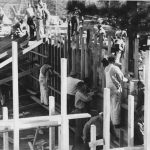The only sustained effort to create a ski resort here in Strawberry Valley began immediately after World War II. In 1946, Jules Berkeley of Los Angeles acquired 37 acres high in Fern Valley below Tahquitz Peak, where he built Hidden Lodge. Taking advantage of a location handy to both the Devil’s Slide Trail and South Ridge, it would feature summer horseback excursions and winter skiing.
For the opening season toboggan slides were laid out, and a ski tow was designed to serve a 3/4-mile-long run. As “Sports Director” (a.k.a. ski instructor), Berkeley had hired an interesting character, Tommi Tyndall. Born Karl-Heinz Popelik, he learned to ski in the Alps during his student days. Needless to say, Dresden, Germany, became an uncomfortable home for a Czech-German Jew in the 1930s. When World War II broke out, he just happened to be in the United States and decided to stay. Penniless, he changed his name and began to scratch out a living by teaching skiing, which would position him to capitalize on the sport’s booming postwar popularity.
Tyndall quickly became Berkeley’s chief assistant, spending much time down in the village building enthusiasm for skiing. Just before the 1947-48 ski season, however, Berkeley decided to withdraw from active management and contracted out individual functions to four separate concessionaires. Tyndall retained skiing, but room rentals went to Mary Duffield, tobogganing to Donald Smith, and the Silver Dollar Café to Jo Kun. With his authority thus curtailed, Tyndall gradually began shifting attention to Big Bear.
Hidden Lodge, at its zenith in mid-February 1948, boasted “two inches of fresh powder atop a hard-packed base of 22 inches,” 2,500 toboggan runs in a single day and night, and skiing and jumping exhibitions. A steady stream of customers was transported between village and lodge in war-surplus “Weasel” tracked vehicles. But it was all downhill from there.
Tyndall left and started his own resort, Snow Summit, at Big Bear, taking Jo Kun along as his wife and business partner. By 1950, Berkeley was marketing the struggling lodge as a conference center, advertising two-bedroom cottages, bunkhouse with sleeping rooms, dining room, swimming pool, horseback riding, 12 ski runs from beginner to expert, and the ever-popular 1,100-foot toboggan slide.
That summer ISOMATA (Idyllwild School of Music & the Arts) opened and took over the resort for faculty and student housing. But large resorts here were passé. By 1957, Hidden Lodge had morphed into a church camp run by the Fortress of Youth Ministry. And in 1959 it went the way of other large Idyllwild tracts, subdivided for cabins and homes.
Ironically, the resort’s moment of glory was still to come. During its subdivision, developer Jerry Johnson had kept the main facilities together as a single property. There they sat two years later, available, when Mirisch Pictures brought Elvis Presley to town, to film “Kid Galahad.”
For three weeks in November 1961, Hidden Lodge was the center of a universe, with Elvis and co-star Joan Blackman backed by a cast that included Gig Young, Lola Albright, Charles Bronson, and Ed Asner, plus some 50 local schoolkids as extras. The lodge became a boxing camp on the screen, while the production company coped with recurrent Santa Ana winds and early snowstorms that ultimately drove them back to Hollywood.
After that climactic moment, Hidden Lodge faded into memory. Further subdivision led to demolition of all but the main lodge, which still stands near the cul-de-sac end of Glen Road. Reportedly remodeled beyond recognition since its movie career, the property has been on the market for several years. Any takers out there for this emblem of Idyllwild’s history?










